Milan Fashion Week A/W 2024: Giorgio Armani to Bottega Veneta
The very best of Milan Fashion Week A/W 2024, from Giorgio Armani’s celebration of renewal to the ’monumental everyday’ at Bottega Veneta
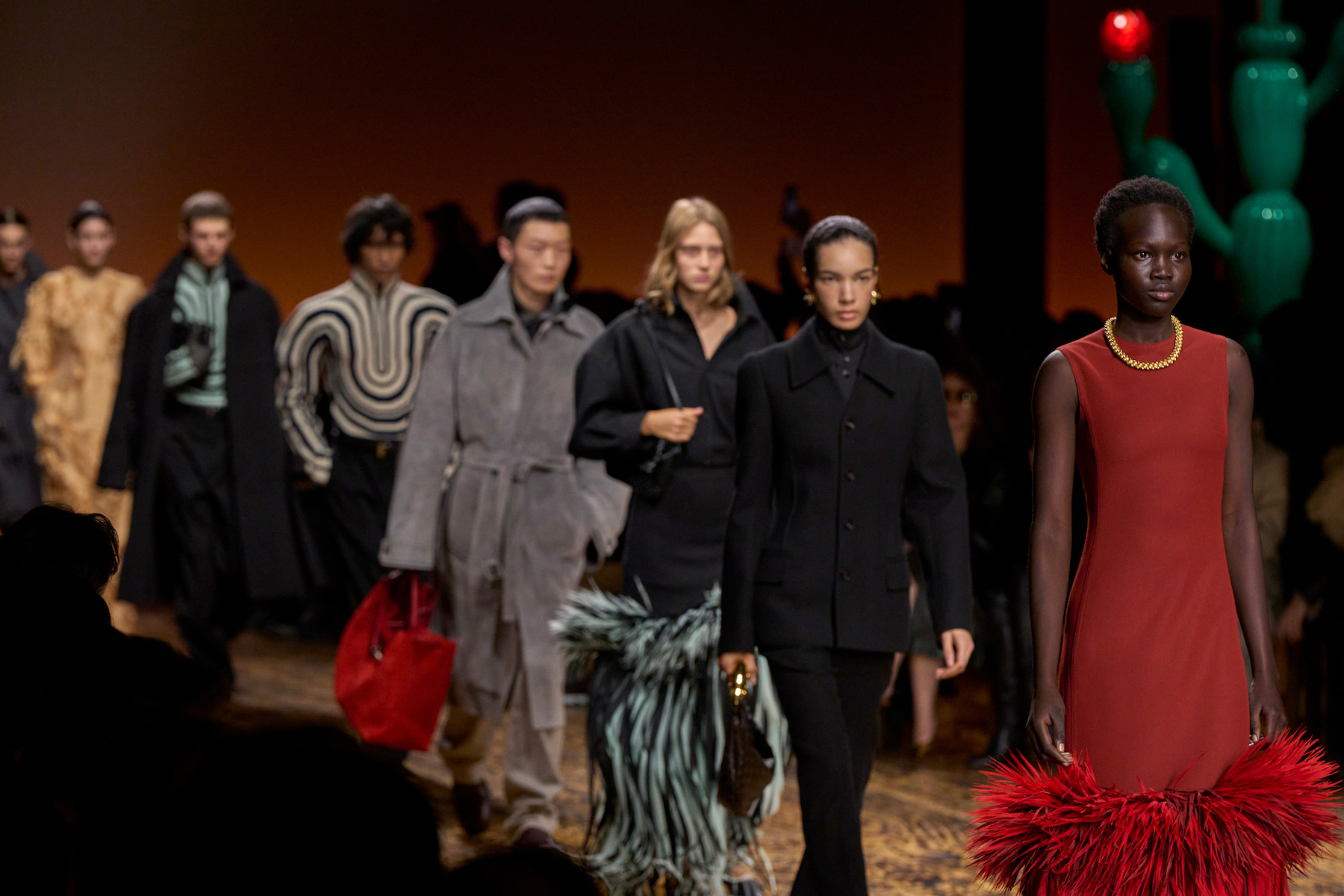
Milan Fashion Week A/W 2024 – which took place in the Italian city last week – was a season of debuts. Tod’s and Blumarine both welcomed new creative directors: the former saw ex-Bottega Veneta designer Matteo Tamburini take the helm, while at the latter, Walter Chiapponi (formerly of Tod’s) replaced Nicolas Brognano. Moschino also welcomed new creative director Adrian Appiolaza, formerly of Loewe, where he was ready-to-wear design director for ten years. Other notable moments included a return to Milan for Marni, which has in recent seasons shown in Paris, Tokyo and New York.
Elsewhere, Prada’s arresting A/W 2024 collection saw Miuccia Prada and Raf Simons mine ‘fragments of the past’ to create a collection of the future, while Matthieu Blazy’s latest outing at Bottega Veneta saw the designer seek to exalt the everyday. ‘In a world on fire, there is something very human in the simple act of dressing,’ he said. Rounding out the schedule were the titans of Italian fashion; among them Giorgio Armani, Max Mara, Gucci, Bottega Veneta, and Dolce & Gabbana.
Here, reported from the shows, Wallpaper* fashion features editor Jack Moss picks the best of Milan Fashion Week A/W 2024 (also see beauty & grooming editor Hannah Tindle’s stand-out A/W 2024 beauty moments from the runway).
The best of Milan Fashion Week A/W 2024
Giorgio Armani
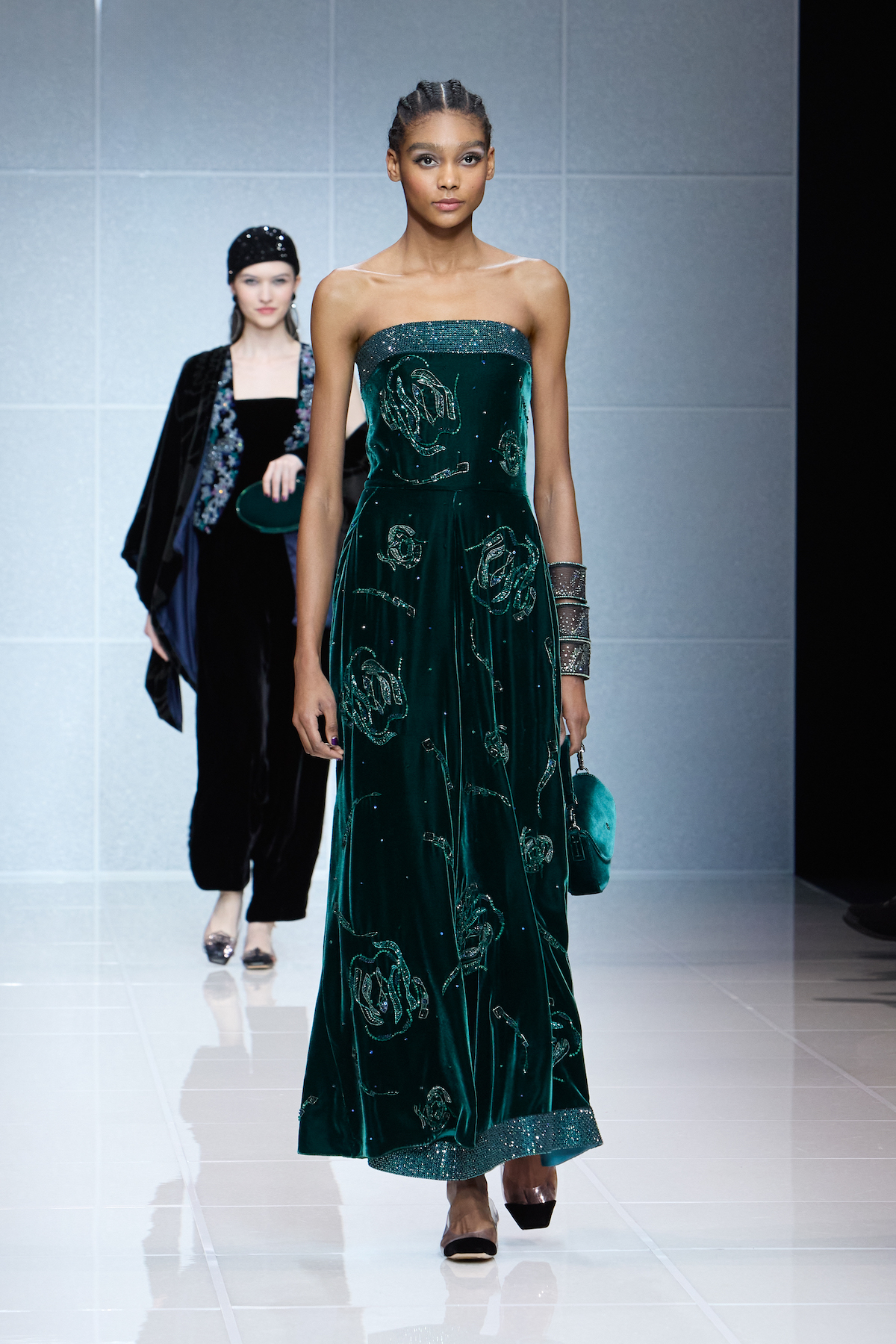
Giorgio Armani A/W 2024
It was left to Mr Armani to close out Milan Fashion Week on Sunday morning, a fitting final act from a designer who for close to five decades has been defining Milanese – and indeed Italian – style. Presented in the intimate Via Borgonuovo space in the house’s longtime headquarters, the designer crafted a collection of languorous glamour which the designer said was inspired by the idea of ‘renewal’. Titled ‘Winter Flowers’, the collection began by looking towards flowers that bloom even in the coldest months and ‘herald beauty and regrowth’ (in this, there was a link to Matthieu Blazy’s Bottega Veneta collection shown the evening before, which looked towards the resilience of desert plants and cacti for his own exploration of renewal). Here, it made for a collection of extraordinary surface embellishment – whether the painterly floral prints which decorated diaphanous layers of organza or dainty beaded dragonflies – in hues of pale blues, rich greens, and the intense nocturnal blacks and navies of the closing looks.
Bottega Veneta
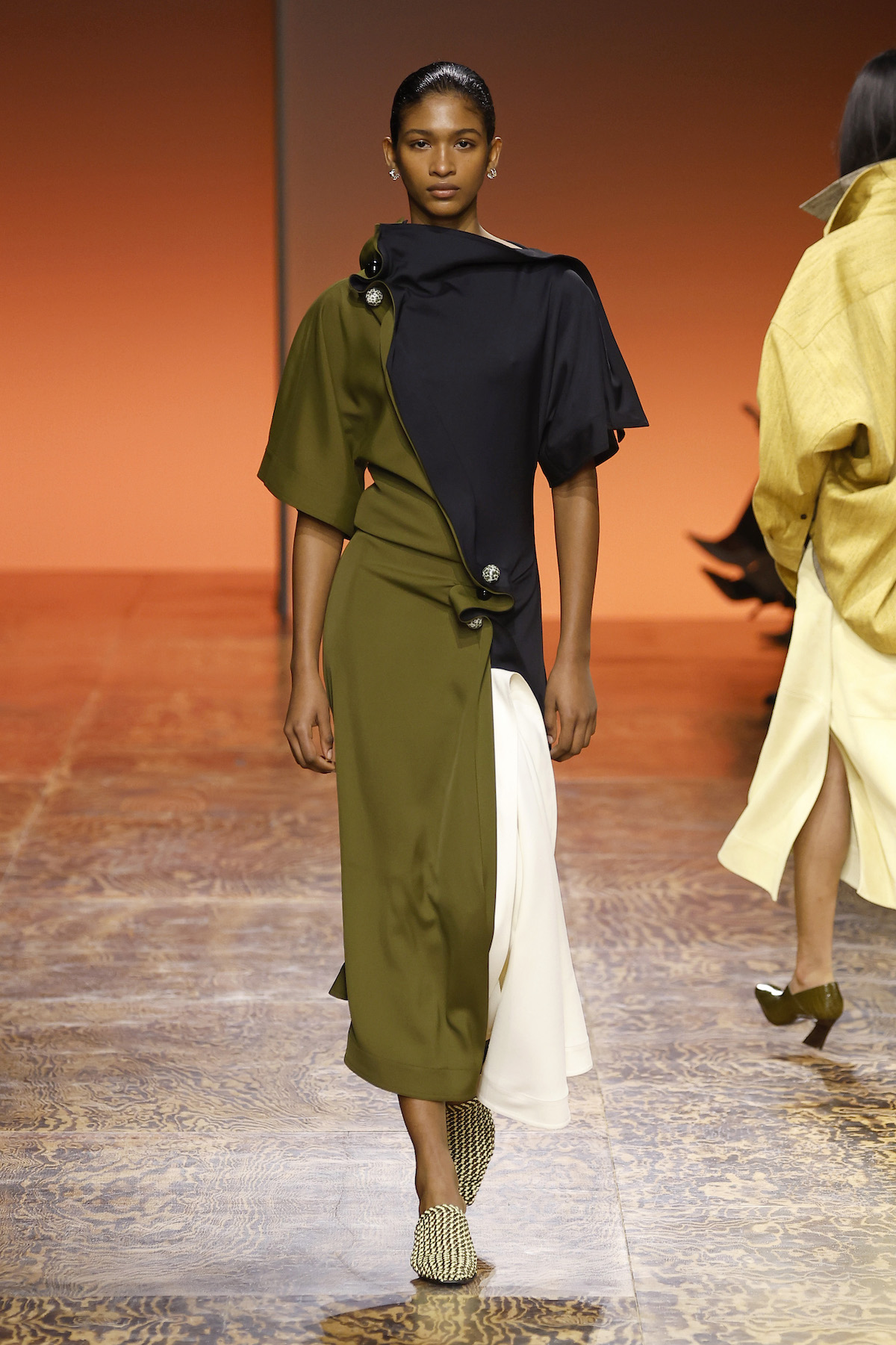
Bottega Veneta A/W 2024
After last season’s round-the-globe ‘odyssey’ – which saw models traverse an enormous tiled map of the world in garments inspired by their imaginative travels – there was a sparser mood to Matthieu Blazy’s latest collection, which took place in a wood-floored show space throughout which giant Murano glass cactuses bloomed. Blazy said the desert plant was a symbol of resilience against the elements; the ability to survive and regenerate even in the harshest landscapes, a mood which was infused into the collection itself. ‘In a world on fire, there is something very human in the simple act of dressing,’ he said, noting that he imagined his figures emerging as if from a burnt and barren landscape to start again. ‘The idea of rebirth is beautiful. These are the flowers that bloom after the earth is burnt – they give a sense of hope. They come back stronger than ever.’
He did so with an exaltation of the everyday, noting a desire to make the quotidian wardrobe ‘monumental’, capturing a ‘sense of allure and confidence in the pragmatic, utilitarian and purposeful’. It made for a typically extraordinary line-up of clothing which saw the recognisable – trench coats, collared shirts, knitwear – energised in new proportions (largely expansive and enveloping, like the cocooning silhouette of the curved seam overcoats which opened the show) and fabrications, which will no doubt require closer inspection to reveal their secrets. Twisted gowns appeared to have been created instinctively, held in place with shiny gobstopper fastenings, while fronds of bouncing pleats at the hems of gowns suggested flames and fire (so too the final slew of dresses, where the fabric looked destroyed and remade). Others were decorated with faded motifs of maps, as if his wanderers were seeking new worlds. ‘We all watch the same news. It is hard to be celebratory at this point,’ said Blazy, noting that getting dressed to begin a new day is an act of human dignity. ‘Here, elegance is resilience.’
Jil Sander
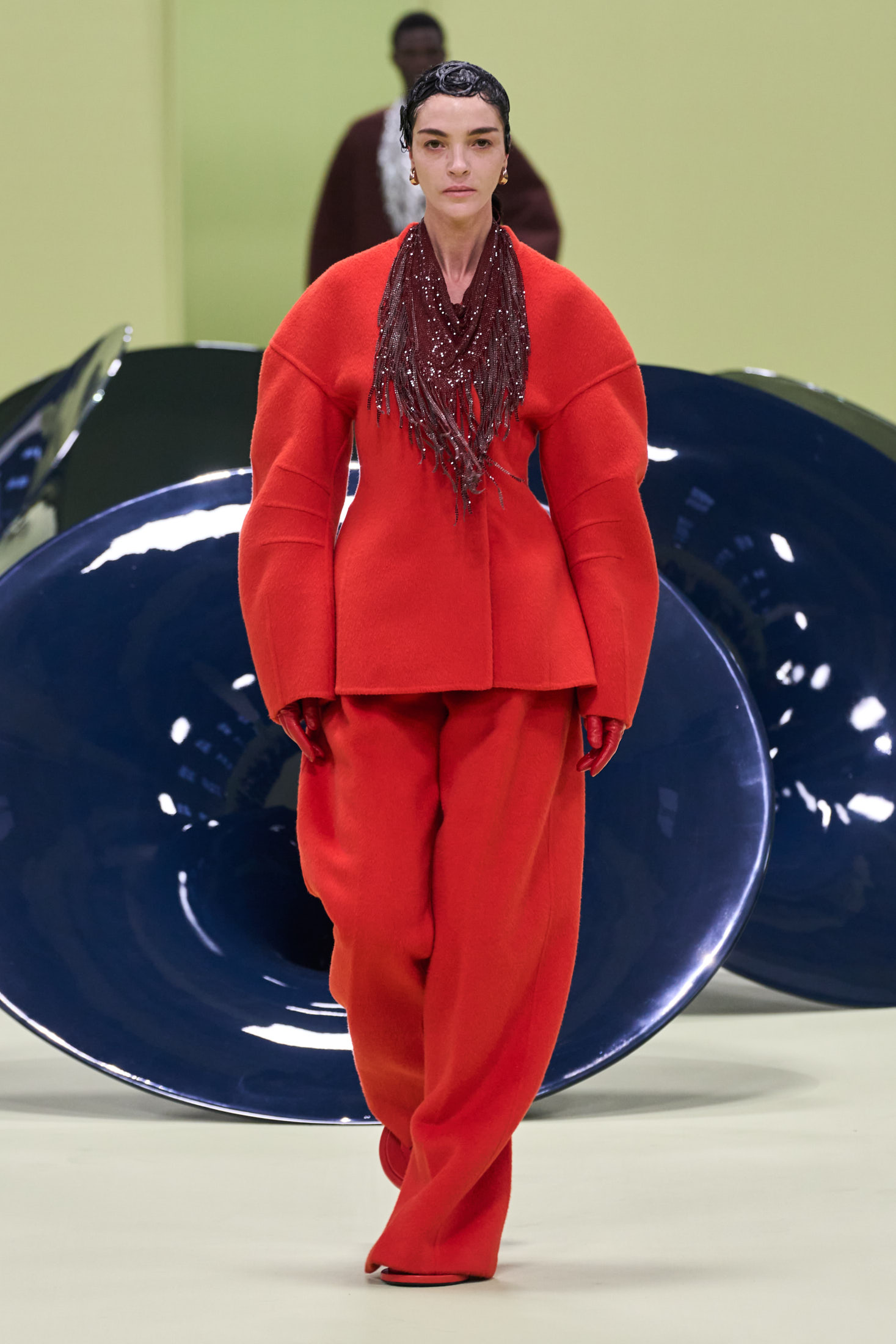
Jil Sander A/W 2024
A collection rich in colour and texture saw Lucie and Luke Meier continue to eschew the idea of seasonal ‘themes’ towards a more wide-ranging evolution of their vision for Jil Sander – one rooted, as the pair describe, in a ‘constant search for a balance between sensitivity and form, intimacy and presence, image and intention, concentration and humour’. Taking place in a green-hued ‘smooth and immersive capsule’, decorated with a collection of enormous cobalt-blue horns, the A/W 2024 collection loosely began with the idea of sound and music, and the way it shapes ‘our emotions; desires and needs’ (a live soundtrack was provided by American singer-songwriter and instrumentalist Mk.gee). There was certainly a feeling of emotion to the collection itself, which shifted from the brightly-hued moulded dresses and tailoring of the opening looks, towards more dramatic silhouettes, like a series of caped gowns which recalled mid-century haute couture in their abundance. Elsewhere, texture and fabrication remained key, whether the quilted down or diaphanous chainmail which suggested protection, or the more whimsical flourishes of floral jacquards, fuzzy handbags, and the long fronds of tassels which trailed from knitwear.
Wallpaper* Newsletter
Receive our daily digest of inspiration, escapism and design stories from around the world direct to your inbox.
Dolce & Gabbana
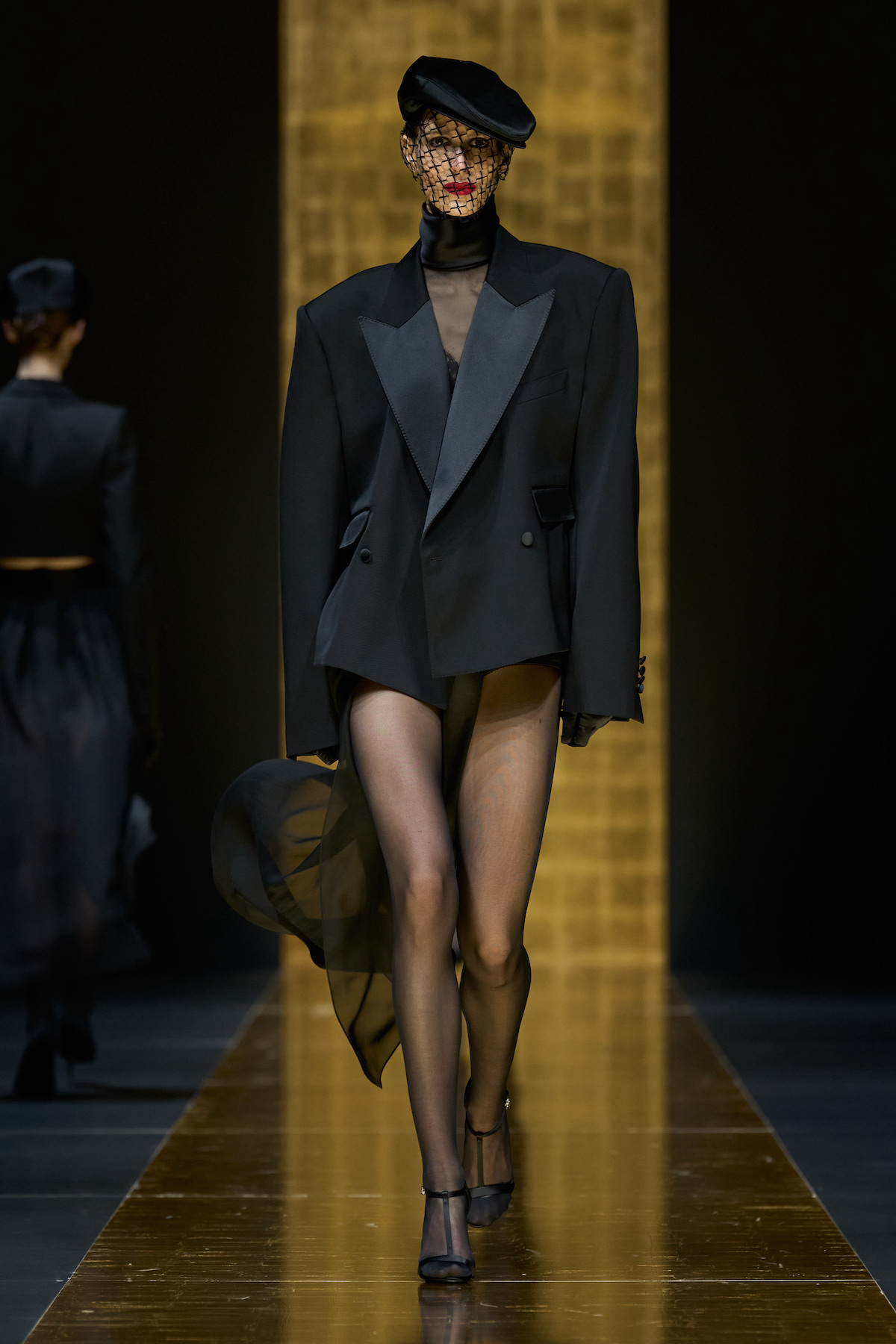
Dolce & Gabbana A/W 2024
Domenico Dolce and Stefano Gabbana looked towards the tuxedo, a symbol of enduring sartorial elegance, for their latest collection, drafting in a blockbuster era-spanning cast – which included Naomi Campbell, Amber Valletta, Mariacarla Boscono and Eva Herzigova – to bolster the collection’s timeless mood. ‘The tuxedo is the ultimate symbol of pure style,’ the designers noted. ‘For us, only style transcends fashion: the simpler a piece, a classic like the tuxedo, the more perfect it is, eternal, free from the constraints of time.’ Alongside a multitude of riffs on the garment – cropped to the navel, blown up in proportion, or elongated into an overcoat – were the requisite flourishes of glamour and sensuality synonymous with the house. These included a series of lingerie-inspired looks (a counterpoint to the rigour of the tuxedo), as well as enormous feathered coats, glimmering crystal chainmail dresses and profusions of lace and polka dots. ‘[It’s a] union of contrasts,’ continued the designers. ‘Masculine and feminine, austerity and seduction… allowing every woman the freedom to express her idea of style.’
Ferragamo
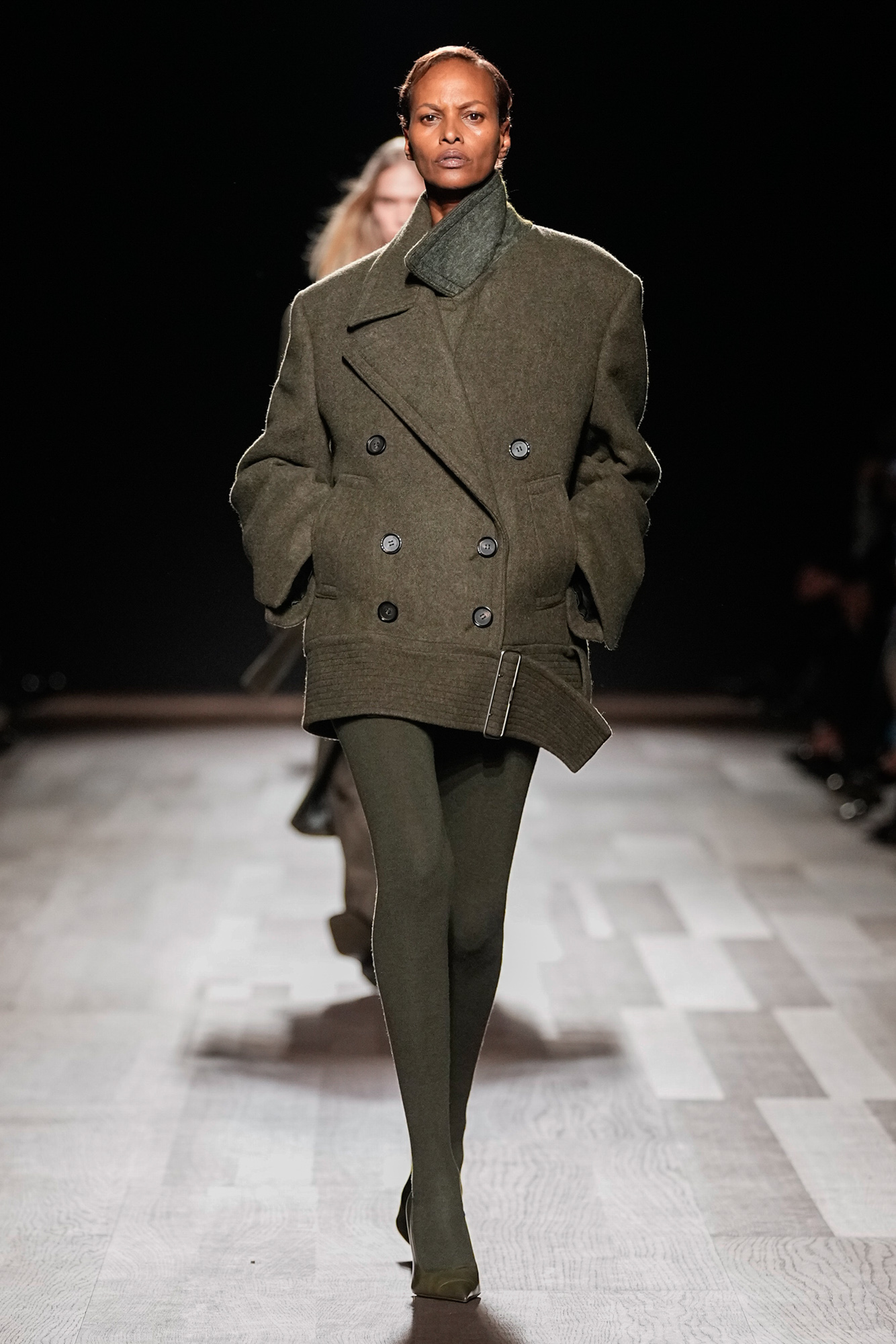
Ferragamo A/W 2024
Maximilian Davis moves from strength to strength with a deeply desirable A/W 2024 collection for Ferragamo, which saw him translate past to present in astute style (‘the goal is to be timeless,’ he recently told Scarlett Conlon in a tour of the house’s archive in Florence, Italy). Here, it was the liberatory mood of the 1920s that provided the starting point of the collection, with Davis noting that it was a decade that ‘used clothing as a way to celebrate freedom.’ ’That expression of freedom is something which resonates with me, with my heritage, and with Ferragamo.’ There was certainly the fluidity of the era’s dress codes, the feeling of casting off restriction and restraint: a silk halterneck gown fell away into tassels at its sheer hemline (a restrained riff on the flapper dress), while layers of transparency ran throughout.
Elsewhere, Davis drew inspiration from Hollywood figures like Joan Crawford and Greta Garbo, noting the way they would adopt elements of masculine dress; here, this meant a series of brilliant wide-shouldered overcoats and tailoring with wide buckled waistbands. For men, a super-abbreviated mini short provided the collection’s defining silhouette, worn with elements which the designer said suggested protection: military-hued tailored jackets, chunky knitwear, riffs on the workwear jacket. A similar line of thinking inspired the cape-like silhouette or the elongated, face-covering collars on outerwear. ‘In the 1920s, as a response to the world that surrounded them, people created their own spaces through speakeasies,’ explained Davis. ‘They were hiding what they were wearing until they were safe.’ Befitting the house’s history, completing the line-up was some terrific footwear – whether elegant T-bar pumps (a stripped-down riff on a style Davis found in the house’s archive), thigh-high wader boots, or those adorned with fronds of colourful sprouting feathers.
Versace
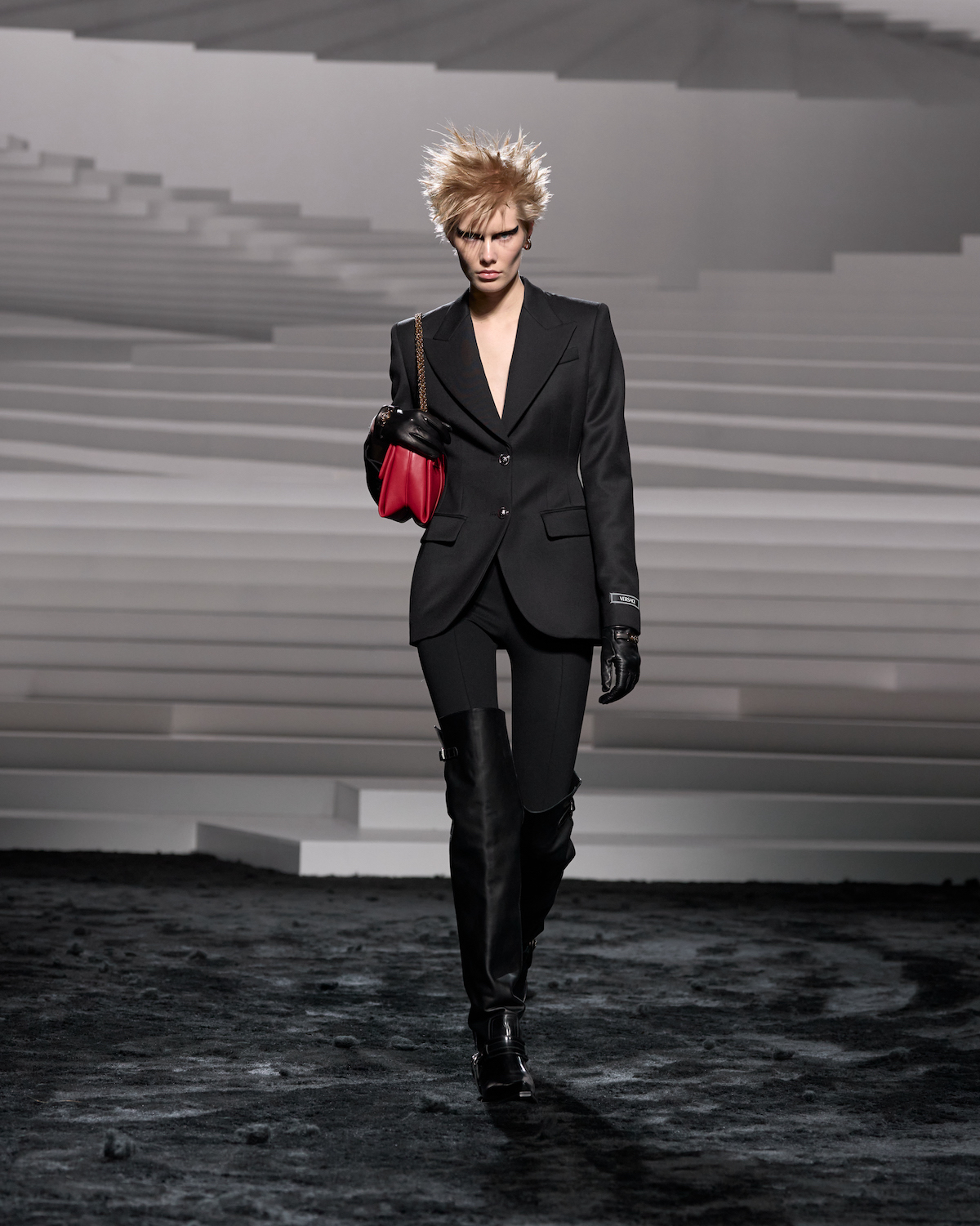
Versace A/W 2024
Donatella Versace closed out Friday evening’s proceedings with a stomping co-ed collection infused with a rebellious, punkish spirit – albeit in the Italian house’s hyper-glamourous style. ‘The woman is a good girl with a wild soul,’ said the designer, who formulated this juxtaposition in prim collared dresses, gold-button blazers and riffs on the tweed suit (here elongated to the point the jacket trailed along the floor) opposed with lashings of eyeliner, distressed leopard print sweaters and chainmail-covered jeans sliced open along their front. Elsewhere, a slew of molten dresses, which contoured the body into a narrow corseted waist, had requisite Versace va-va-voom (so much so, actress Anne Hathaway chose one of them to wear while she watched on from the front row). Nods to archival prints, meanwhile, appeared across both the men’s and womenswear collections. ‘This is a collection with a rebel attitude but a kind heart,’ elaborated the designer. ‘Pure lines, innovative fabrications, considered wildness. This is us. This is Versace.’
Marni
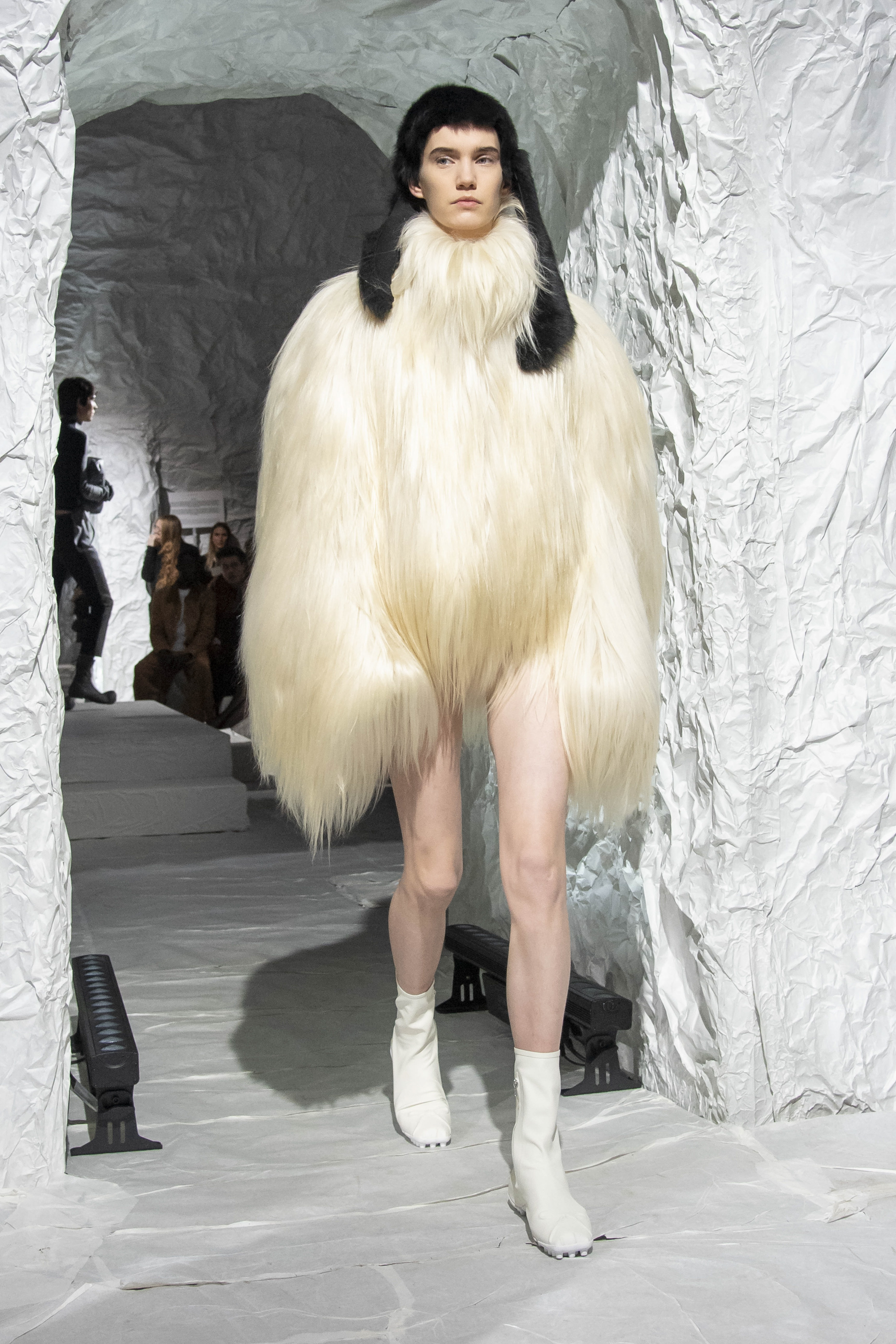
Marni A/W 2024
After a sojourn around the world, hosting shows in New York, Tokyo and Paris, Marni creative director Francesco Risso returned to Marni this season for a show held in the railway arches on Via Ferrante Aporti. Here, they had been entirely covered in crinkled white paper – one fellow attendee described the effect as feeling as if inside a papier maché igloo – providing a symbolic link to the collection itself, which had begun with a blank slate. Titled ‘Bring No Clothes’ (a reference to Virginia Woolf’s instructions to those visiting her home in the British countryside), Risso said that reference images were banned from the walls of the studio this season, inviting his design team to instead work by instinct and through play. ‘By casting out the idolatry of mirrors, filled to the brim with conquering dreams, we have returned to an almost animal state,’ he wrote in the show’s accompanying letter of intent. Indeed, the collection did have a primitive air: sliced panels of fur slung around models’ necks or trailing in their wake, moments of animal print, and fuzzy, enveloping textures. A mood of childlike creativity, meanwhile, was captured in a series of naively painted garments, their texture raised like an oil painting.
‘For some months now, I’ve been asking myself what it would mean to return to that original state of creation,’ elaborated Risso. ‘In a letter inviting her friends to the countryside, Virginia Woolf once wrote “bring no clothes”. I came to understand that she wasn’t suggesting they arrive naked, but simply encouraging them to strip back the punitive structures of clothing, and all their symbolic implications, because here, it’s just us. It’s a sentiment familiar to my early days in the studio – a sense of community that extended deeper and beyond our titles and roles... because here, it’s just us.’
Gucci
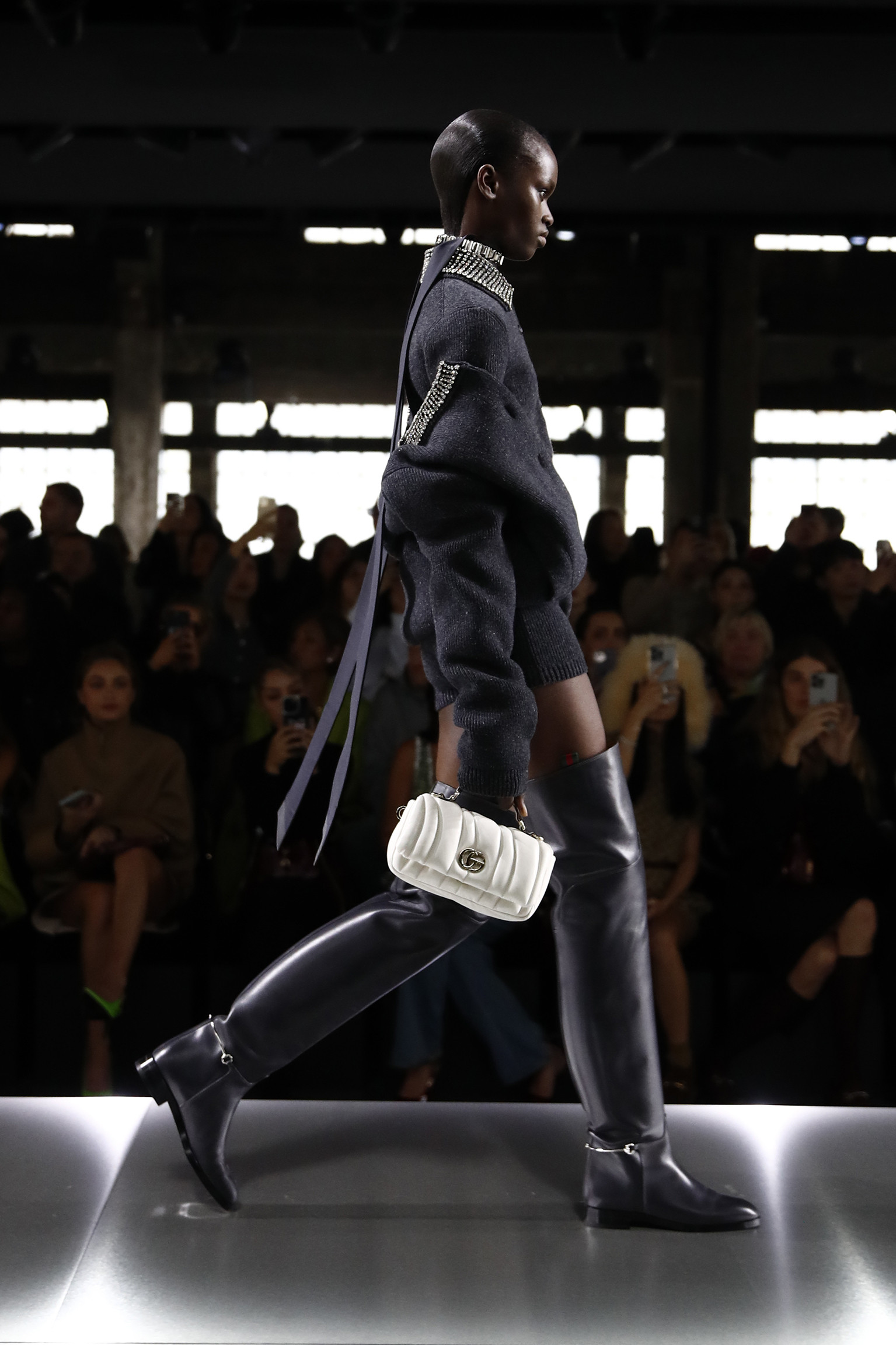
Gucci A/W 2024
Sabato De Sarno’s sophomore womenswear collection continued in much the same vein as his debut, seeing the Italian designer attempt to capture the essence of his native country’s style in contemporary manner – all the while infused with a mood of insouciance and romance. ‘My dreams, as with my fashion, always converse with reality,’ he elaborated in a brief note circulated prior to the show, which was held in the industrial Fonderia Carlo Macchi. ‘Because I am not searching for another world to live in, but rather of ways to live in this world.’ For him, this means an exploration of the quotidian wardrobe enlivened with the flourishes of glamour and embellishment made possible by the Gucci atelier: mannish overcoats were adorned with a waterfall of sequins and paillettes, intricately layered lace cami tops and dresses recalled lingerie, while slouchy knit cardigans came with shimmering crystal-decorated collars. Elsewhere, tailoring was nipped and worn with abbreviated shorts (the silhouette seemed to recall the 1960s), while an impressive array of leather jackets punched with the double-G monogram showed off the house’s expertise in the material. It ended with a duo of carved strapless gowns, which were seductive in their simplicity, though with enough pizzazz to please his celebrity-filled front row (this season, it comprised Solange Knowles, Kirsten Dunst and De Sarno’s house muse, British actress Daisy Edgar-Jones). ‘[I want to] capture the extraordinary where the ordinary is expected,’ he said.
Sportmax
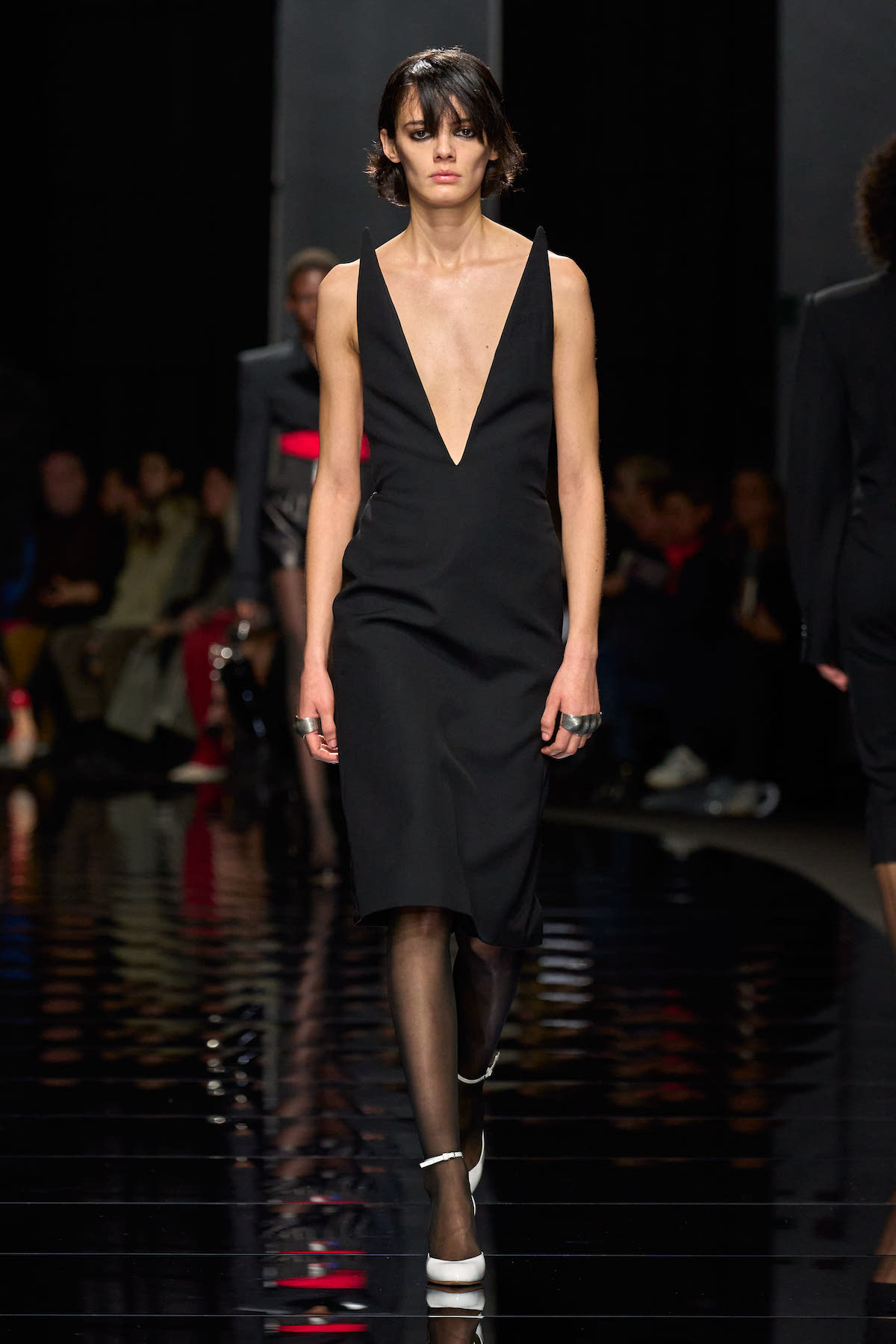
Sportmax A/W 2024
This season the Sportmax design team diverted from the futuristic austerity of S/S 2024’s all-white collection, looking instead towards underground icon Nico – in particular, her final 1985 album Camera Obscura – for inspiration. On the collection notes, a quote from Gerard Malanga (a poet and assistant to Andy Warhol) about the album’s imagery was chosen to encapsulate the collection’s mood. ‘Nico’s eyes seem to guard a great mystery which, hidden in aloofness, they do not want anyone to know exists,’ it read. ‘Whether or not a mystery is there, the eyes with the enigma of their absence from what surrounds them eclipse the perfection of features and form to add great magnetism’.
So the woman for this season was steeped in sensuality and intrigue, seeing models stalking the dimly lit upper corridors of the Triennale di Milano contemporary art museum on a curving mirrored catwalk (on which the season’s vertiginous heels pounded). Plunging black mini dresses rose up above the shoulder into spikes, while sharp, wide-shouldered tailoring and a recurring cinched waist (often achieved through clever layering) was designed to recall the ‘resolve of a Helmut Newton muse’. Meanwhile, Nico’s 1980s contemporaries – Grace Jones, Debbie Harry, Annie Lennox and Siouxsie Sioux – were also celebrated in the nostalgic album cover-inspired prints, dotted across the collection like a collage.
Tod’s
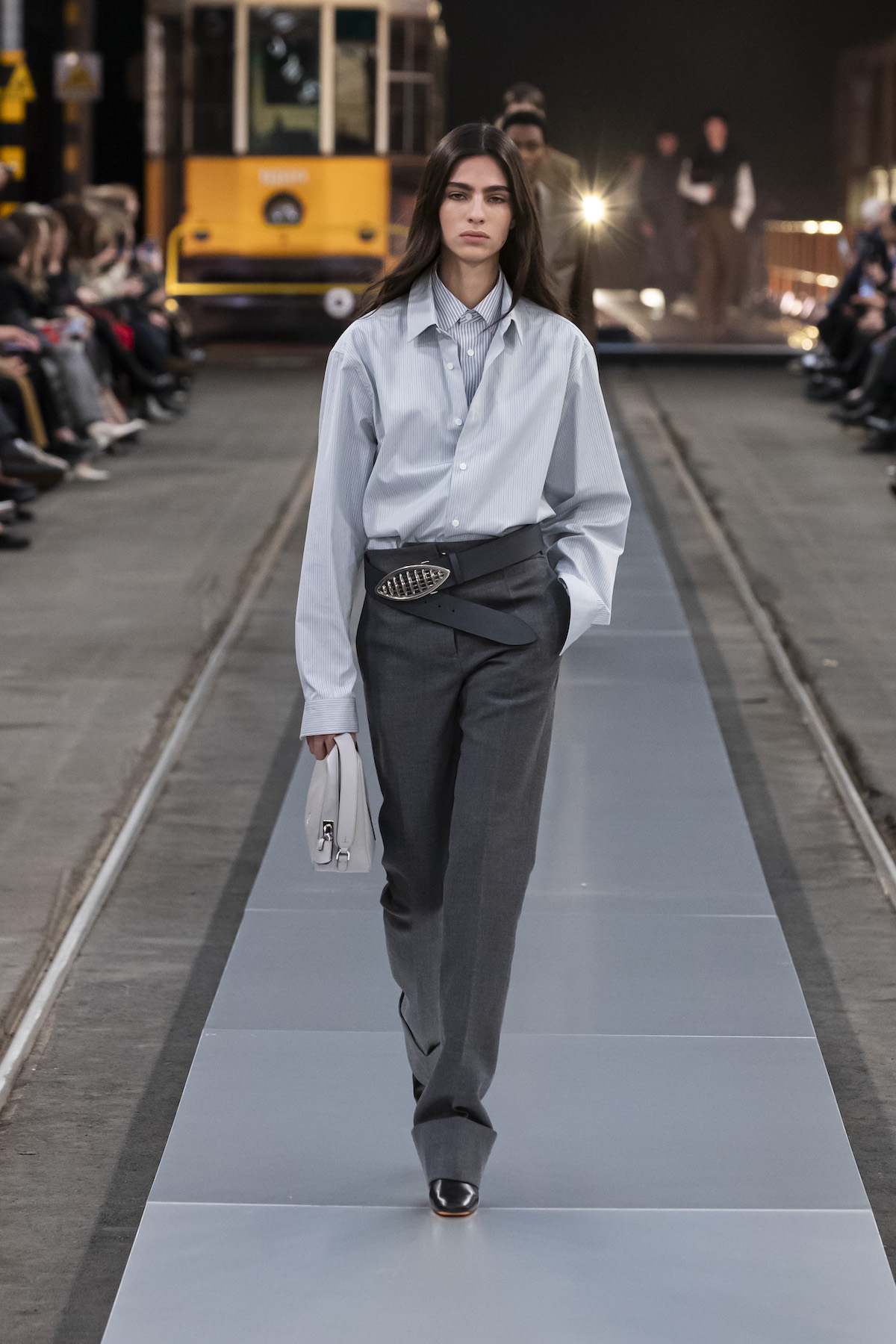
Tod’s A/W 2024
Matteo Tamburini chose the Messina Tram Depot in northern Milan to present his debut Tod’s collection, a symbolic gesture that this was a brand in forward movement (indeed, a number of the yellow Milanese trams had been adorned with the Tod’s logo for the occasion). It linked with the collection’s inspirations, which the designer said was rooted in a search for contemporary Italian elegance – one at once inspired by the energy of the street (here epitomised by the presentation, where models appeared to be rushing to catch the tram on a misted morning) and a deep-rooted appreciation for local craft. So for men and women, Tamburini attempted to create a comprehensive everyday wardrobe in luxurious style, from layers of ribbed knitwear and roomy trench coats to more dramatic leather gowns adorned with tassels (in these, there was an echo of Bottega Veneta, where Tamburini worked from 2017 to 2023). The designer was at his best, though, with the narrow, streamlined looks which opened the show, comprising sharply cut overcoats, double-layer striped shirts and gently flared tailored trousers with wide folded hems – a convincingly contemporary silhouette. As for footwear – which remains the bedrock of the brand – a version of the Gommino loafer for men with a minimal metal bar in lieu of the usual tie fastening had definite appeal, while for women the style was adorned with playful fronds of leather tassels.
Prada
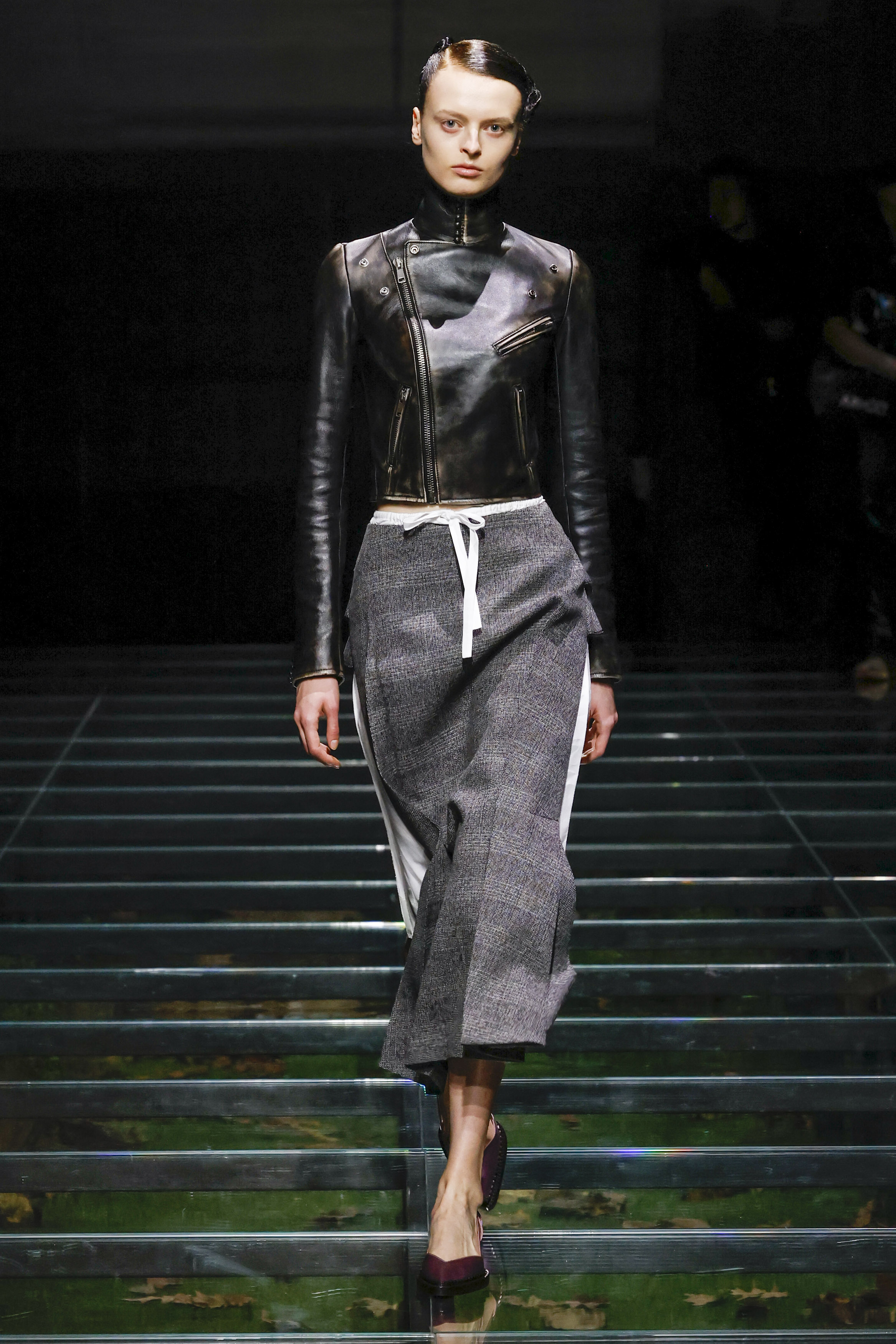
Prada A/W 2024
‘An instinctive attraction to history.’ So began the description of Prada’s A/W 2024 show, which was presented in the same OMA/AMO-designed space as the house’s menswear show in January, where vast Perspex tiles revealed a simulacrum of a forest floor beneath attendees’ feet (this time, the twisting lines of spinning office chairs had been removed; so too the desks and Prada-screensaver computers which had stood in the space’s entranceway). Though still striking, the set felt less prescient here – in the menswear show, its clash of the great outdoors and the corporate office was reflected in the clothing itself – with co-creative directors Miuccia Prada and Raf Simons instead looking towards ‘fragments’ of historical dress as the collection’s starting point. (Read more about OMA/AMO and Prada show sets in our Rem Koolhaas interview on 25 years of the collaboration.)
But this was not about misty-eyed nostalgia – something Miuccia Prada asserted, in typically plain-speaking style, that she ‘hates’. Rather, it was what the pair deemed an ‘emotional’ exercise – an exploration of the way clothing holds onto memories, even romance. ‘History, for me, is always connected to the lives of people,’ explained Miuccia Prada. ‘There is a sense of romance to this collection – of values of love and caring embedded in the clothes… it is not so much a theoretical statement, but a conversation about emotions. For me, these are vital ideas, they are always present in what we create. Creating beauty, creating things with love.’
So there were dresses decorated with a multitude of bows, petticoat-style slips revealed beneath sliced-away skirts, or sculpted tailoring recalling a midcentury silhouette. ‘[They] could be Victorian, 1920s, 1950s,’ said Simons of the references, which were shaken up to create the richly imagined collection. ‘This is not about a narrative history… it’s an attraction to different moments in time which now feel new.’ Other pieces worked in the other direction: a series of technical anoraks, for example, were reshaped using a historical line, imbued with new elegance.
But there was a sense of warning here, too. The profusion of feminine adornments, from bows to ruffles, had an uncanny effect (‘Why do they persist? Why do they attract?’ asked the pair via the collection notes), while suggestions of military attire lent the collection an undercurrent of lingering darkness. As one expects from Prada, this felt purposeful. ’Reflecting on history teaches us our mistakes, our strengths. The past is the only thing we have,’ said Miuccia Prada. ’This is a collection shaped by history… who we were, why we dressed like that. It’s about remembering our past, using this knowledge to move forwards.’
‘In this moment, which is such a complicated moment, it is vital to know your history. Who you are, where you come from,’ added Simons. ‘You can only realise your future if you know your past.’
Emporio Armani
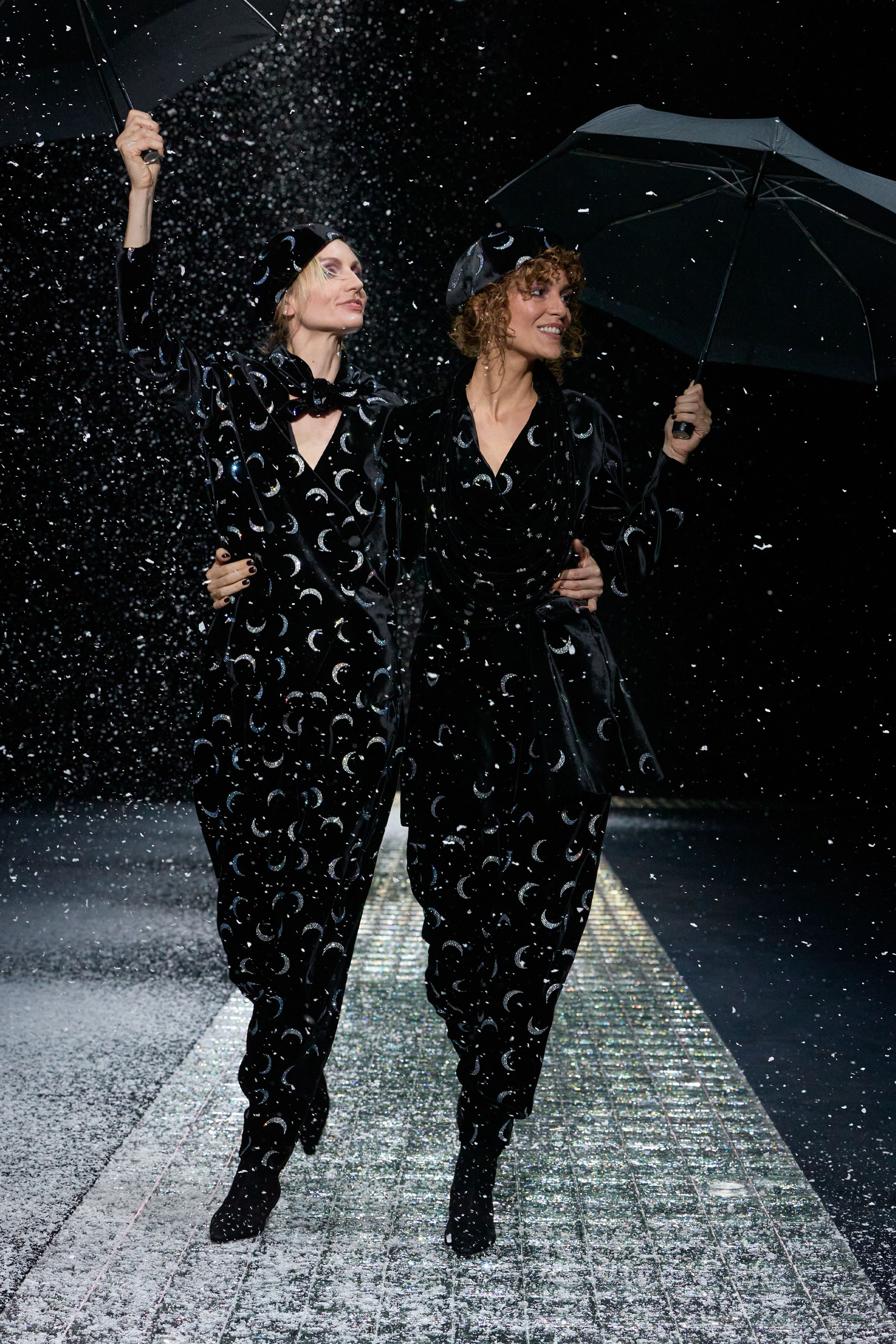
Emporio Armani A/W 2024
Starting backwards, Emporio Armani’s A/W 2024 show ended with a flurry of snow (a micro-trend in Milan, with Jacob Cohën’s presentation earlier in the day at Teatro Lirico complete with its own blizzard of faux-snow). Through it Mr Armani’s models marched, umbrellas overheard and seemingly unfazed by the change in weather, clad here in a series of eveningwear looks in lieu of more temperature-appropriate wear – from sequinned tuxedos and shimmering crescent-moon adorned suits to crystal bra tops and sculpted evening gowns. They captured the mood of the collection, which was titled ‘Night Glow’, seeking to evoke the ‘luminous night sky’ and its changing tonal hues (the colour palette spanned midnight black to mauve, violet, jade green and tones of grey). Silhouettes, meanwhile, were designed to capture the feeling of freedom which remains at the heart of Emporio Armani – whether billowing trousers with sweatpant-style gathered hems, diaphanous organza skirts, or the boldly coloured flourishes of chubby faux fur.
Max Mara
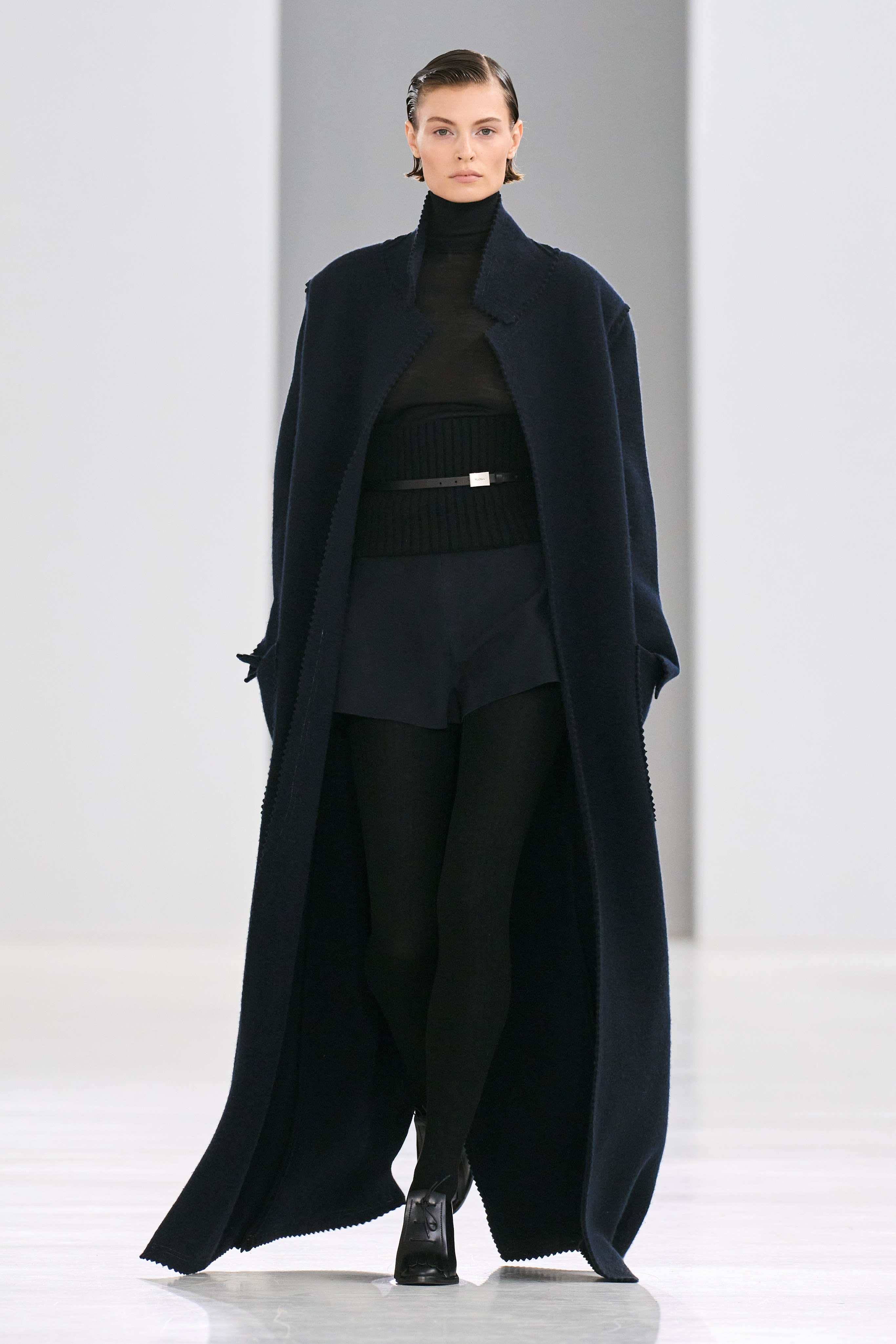
Max Mara A/W 2024
During his three-plus decades at the helm of Max Mara, Ian Griffiths has established a canon of notable women from history to provide the inspiration for his collections. Such was the case for his A/W 2024 offering, presented on a drizzly Milanese morning in a brightly lit former industrial space on Via Giovanni Battista Piranesi. This season, it was the turn of rebellious French author Colette, who is best known for her sensual prose that at the turn of the 20th century provided a then-rare glimpse into the interior life of a woman, her passions and desires. In this spirit, what followed was a seductive collection which suggested moments of pleasure: typically enveloping overcoats in soft-to-the-touch textures, ribbed knit bands which gently cinched the waist, or asymmetric skirts draped and folded onto the body. The subtle juxtapositions which have become a signature of Griffiths’ tenure ran throughout – between weight and lightness, glamour and ease, the masculine and feminine – like his riff on a military officer’s coat or fisherman’s sweater, a nod to the way Colette would defiantly dress between genders. At the end of the press notes, a quote from the author seemed to define the liberated collection: ‘Beautiful? For whom? Why, for myself, of course.’
Fendi

Fendi A/W 2024
The Fendi showspace on Via Solari was divided into various rooms, their partitions constructed from enormous drapes of coloured silk. Indeed, the collection itself – which creative director of couture and womenswear Kim Jones said began by looking at archival looks from the mid-1980s – was full of such impressive contortions of fabric, whether the cinching day-glo strip of fabric which was layered over a simple black roll-neck, or the variously complex knits, which were crisscrossed over the neck or became slinky, colour-blocked ribbed dresses. The drapes also recalled those found in Roman statuary – a nod to Fendi’s home city – which also appeared as prints or as intricate embroidery on the garments themselves, part of a continuing exploration of the Italian city’s unique brand of elegance (a fascination of Jones since he started at the house, who takes particular inspiration from the personal style of house scion Delfina Delettrez Fendi, who in 2020 became Fendi’s artistic director of jewellery and in 2016 was a Wallpaper* Design Awards judge).
But delving into the archive also reminded Jones of the dress codes of his native London in the 1980s, particularly the vivid, subversive uniforms of the New Romantics and figures like performance artist and club impresario Leigh Bowery. Here, the liberated mood of the era was expressed in flourishes of polka dots (a Bowery signature) and moments of piercing colour, which contrasted rigorous, sculpted black tailoring elsewhere. ‘The sketches reminded me of London during that period: the Blitz Kids, the New Romantics, the adoption of workwear, aristocratic style, Japanese style,’ Jones explained. ‘It was a point when British subcultures and styles became global and absorbed global influences. Yet still with a British elegance in ease and not giving a damn what anybody else thinks, something that chimes with Roman style.’
No. 21
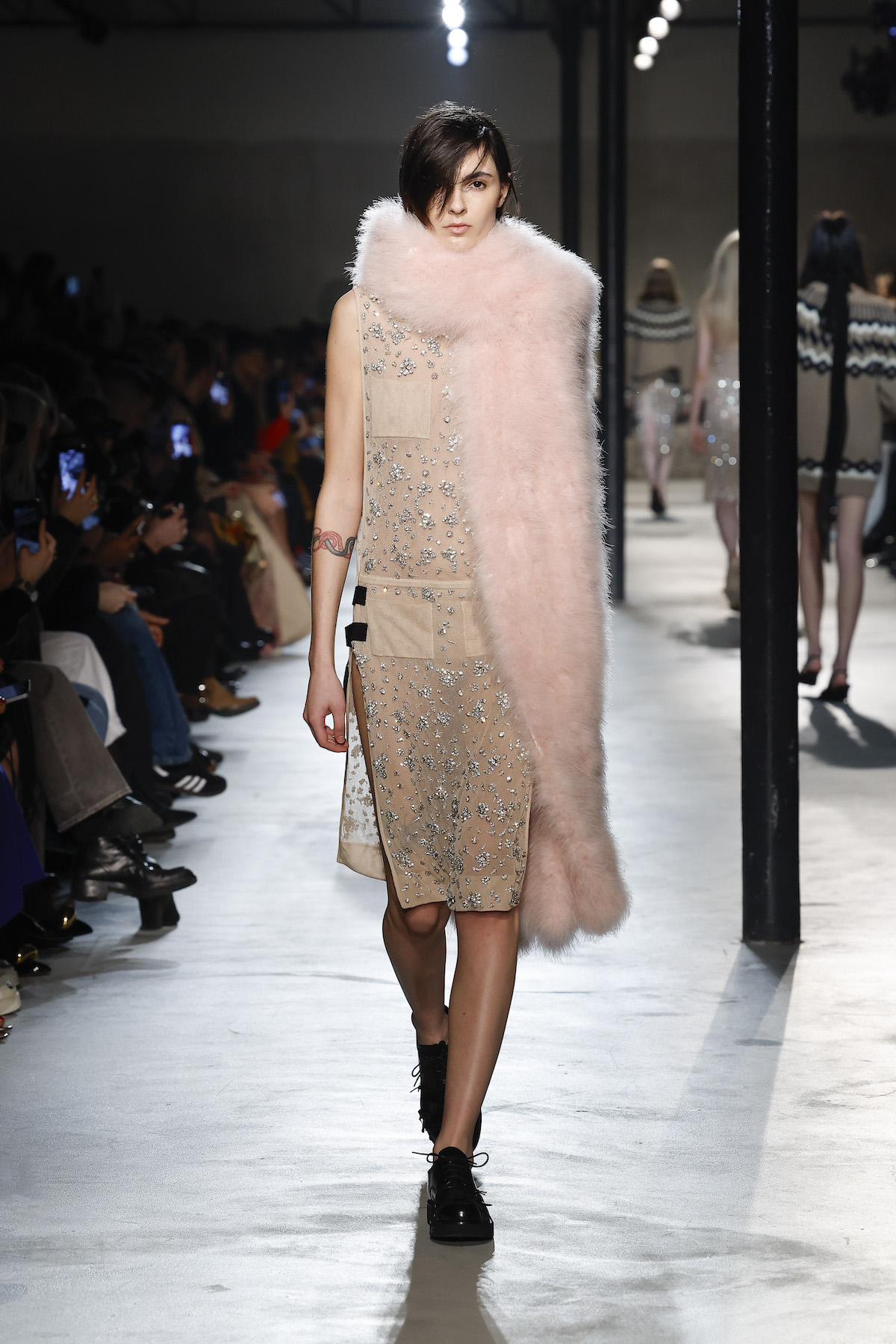
Alessandro Dell'Acqua’s always intriguing vision of womanhood at No. 21 – where underneath his clothing’s exterior beauty something darker lurks – continued this season with the Italian designer’s riff on bourgeois dress codes. He used the expression ‘bon ton’, a byword for elegance and good taste that was first used to describe British high society in the 19th century – and later reemerged during the haute couture revival of the 1980s – to encapsulate the collection’s mood. The latter era emerged here in plunging black gowns that tied at the shoulders with bows, cocooning double-breasted overcoats, or nipped tweed suiting, all of which drew inspiration from the decade’s outré haute couture collections (‘It’s as if I had cast my gaze deeply into a fashion story [and made it] come alive again,’ said Dell’Acqua of the nostalgic mood). But it was the designer’s eye for juxtaposition that continued to enchant: whether the functional, harness-style fastening which sat in the side seam of an otherwise ladylike dress dripping in crystals (and exposed the body beneath), the men’s brogues worn with a satin strapless gown, or the combination of a slouchy Fair Isle jumper with an embellished sheer skirt and pointed pumps, each combination captured the disruptive sensuality which pulsates through his work. ‘[I wanted] to capture and express a very conscious form of bourgeois eroticism,’ Dell’Acqua concluded.
Jack Moss is the Fashion Features Editor at Wallpaper*, joining the team in 2022. Having previously been the digital features editor at AnOther and digital editor at 10 and 10 Men magazines, he has also contributed to titles including i-D, Dazed, 10 Magazine, Mr Porter’s The Journal and more, while also featuring in Dazed: 32 Years Confused: The Covers, published by Rizzoli. He is particularly interested in the moments when fashion intersects with other creative disciplines – notably art and design – as well as championing a new generation of international talent and reporting from international fashion weeks. Across his career, he has interviewed the fashion industry’s leading figures, including Rick Owens, Pieter Mulier, Jonathan Anderson, Grace Wales Bonner, Christian Lacroix, Kate Moss and Manolo Blahnik.
-
 Put these emerging artists on your radar
Put these emerging artists on your radarThis crop of six new talents is poised to shake up the art world. Get to know them now
By Tianna Williams
-
 Dining at Pyrá feels like a Mediterranean kiss on both cheeks
Dining at Pyrá feels like a Mediterranean kiss on both cheeksDesigned by House of Dré, this Lonsdale Road addition dishes up an enticing fusion of Greek and Spanish cooking
By Sofia de la Cruz
-
 Creased, crumpled: S/S 2025 menswear is about clothes that have ‘lived a life’
Creased, crumpled: S/S 2025 menswear is about clothes that have ‘lived a life’The S/S 2025 menswear collections see designers embrace the creased and the crumpled, conjuring a mood of laidback languor that ran through the season – captured here by photographer Steve Harnacke and stylist Nicola Neri for Wallpaper*
By Jack Moss
-
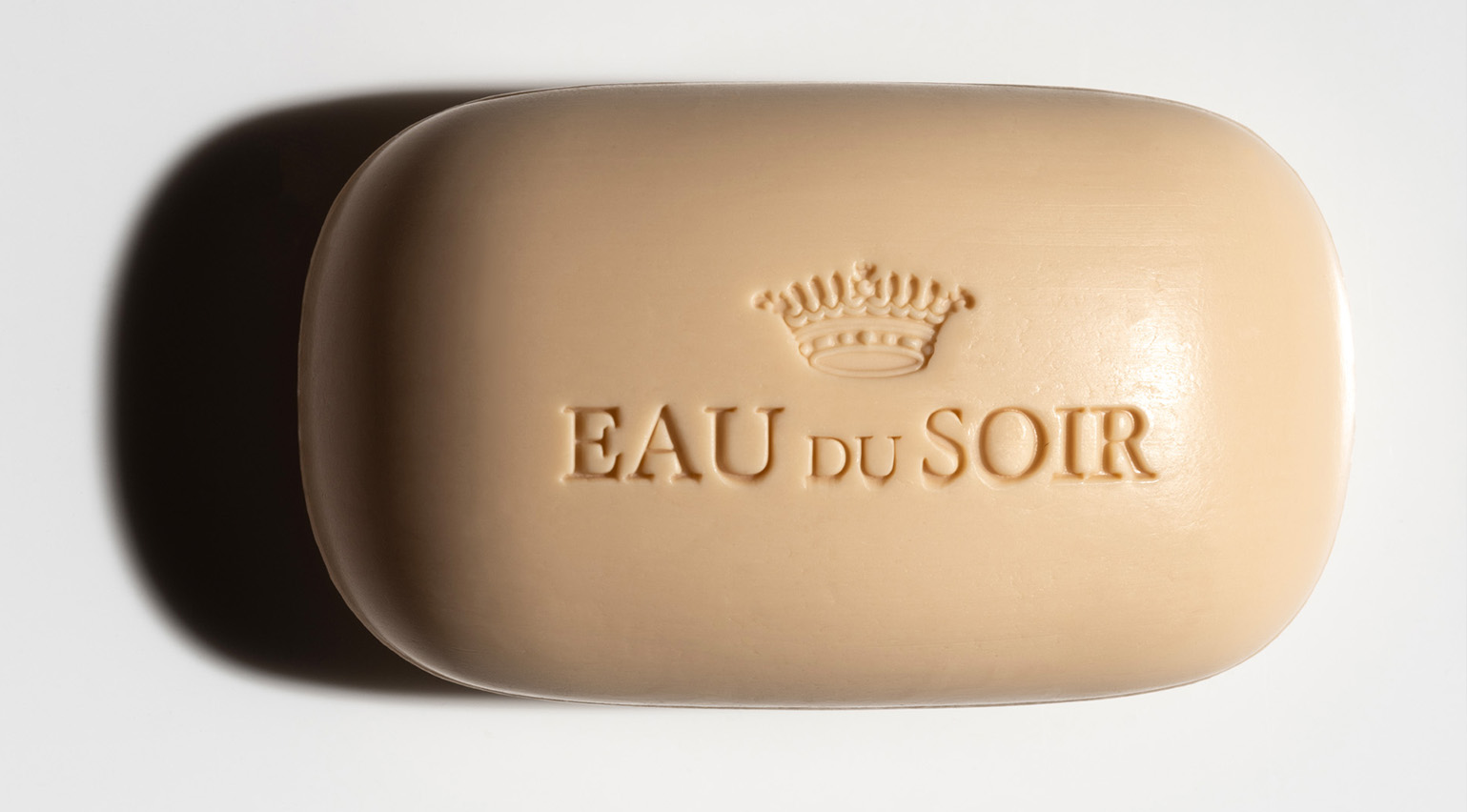 Unboxing beauty products from 2024, as seen on the pages of Wallpaper*
Unboxing beauty products from 2024, as seen on the pages of Wallpaper*Wallpaper's 2024 beauty picks included Chanel lipstick, Bottega Veneta perfume and solid soap from the likes of Aesop, Celine, Diptyque, Hermès and Sisley
By Hannah Tindle
-
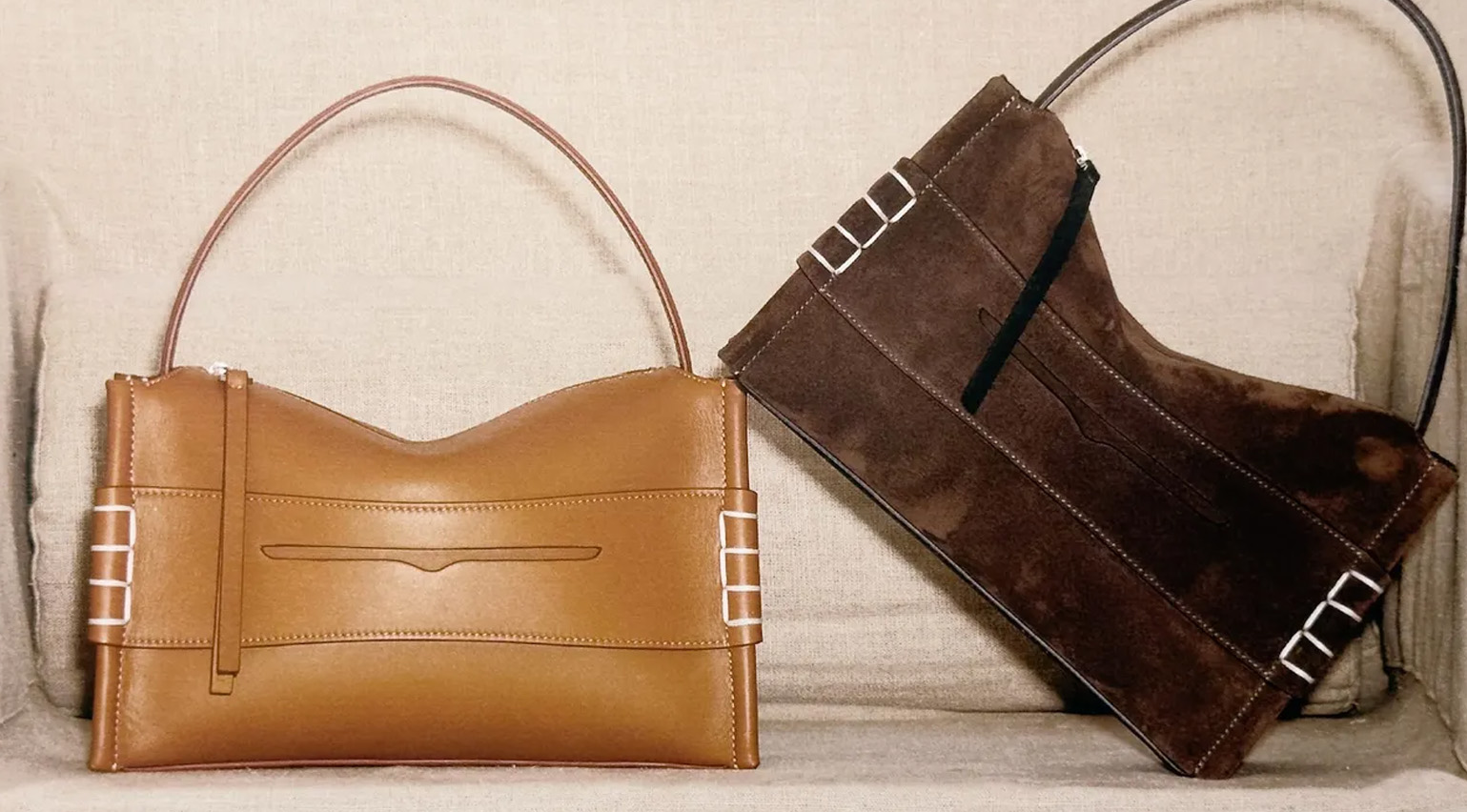 Loafer bags to sock shoes, 2024 was all about the mashed-up accessory
Loafer bags to sock shoes, 2024 was all about the mashed-up accessoryWallpaper* fashion features editor Jack Moss reflects on the rise of the surreal hybrid accessory in 2024, a trend which reflects the disorientating nature of contemporary living – where nothing is quite what it seems
By Jack Moss
-
 ‘He made something not merely popular, but the rage’: unpacking Elio Fiorucci’s fabulous fashion legacy
‘He made something not merely popular, but the rage’: unpacking Elio Fiorucci’s fabulous fashion legacyAn expansive new retrospective at Triennale Milano explores the colourful life and work of Elio Fiorucci, who is synonymous with 1970s hedonism and glamour
By Zoe Whitfield
-
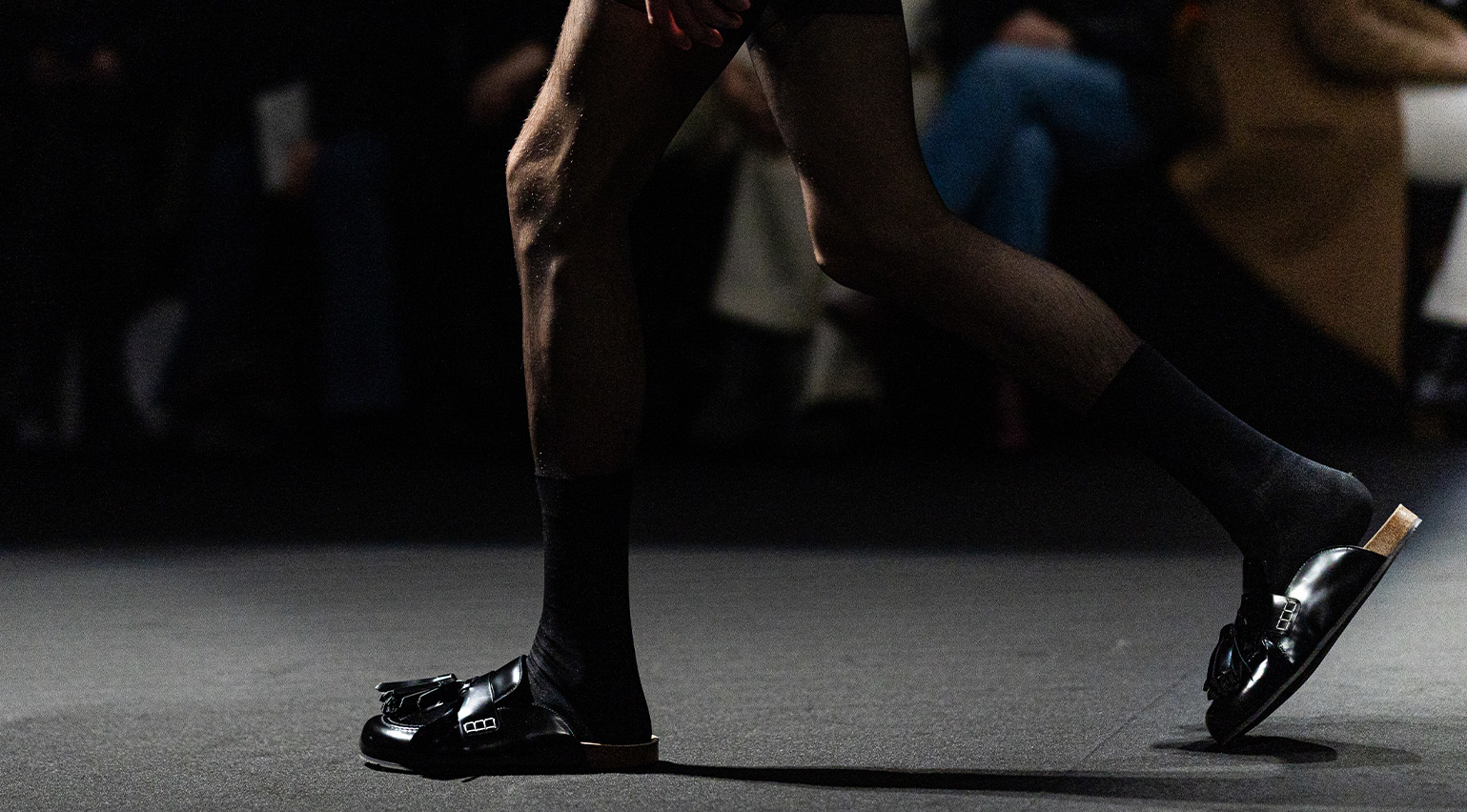 Why the slipper is set to be this season’s definitive men’s shoe
Why the slipper is set to be this season’s definitive men’s shoeWallpaper* fashion features editor Jack Moss unpacks the rise of the men’s slipper, which looks set to become this season’s most ubiquitous shoe. Plus, five styles to channel the slipper’s louche elegance in your own wardrobe
By Jack Moss
-
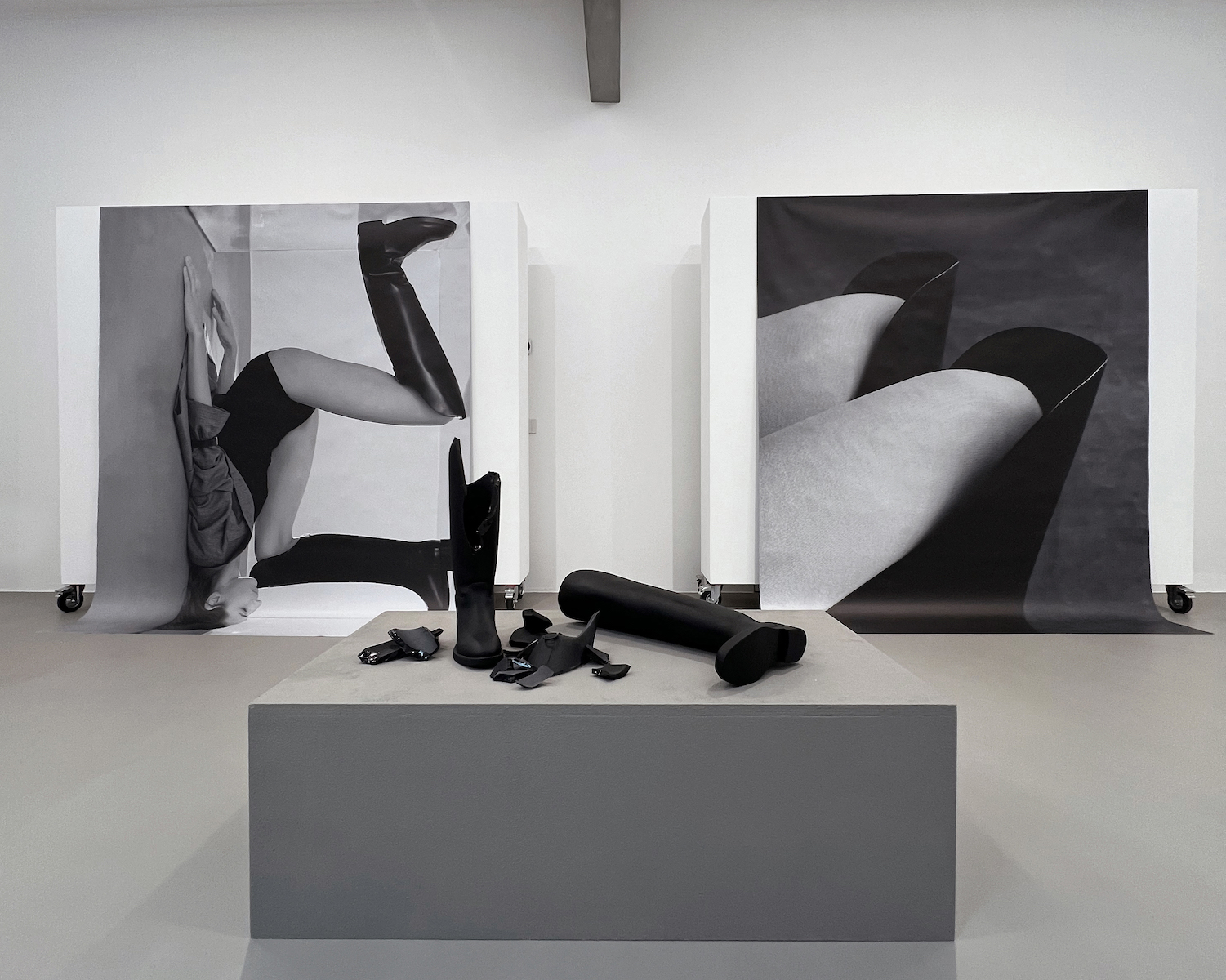 How fashion designer Ilenia Durazzi designed her ‘elegant, rigorous’ Milanese studio – all the way down to the furniture
How fashion designer Ilenia Durazzi designed her ‘elegant, rigorous’ Milanese studio – all the way down to the furnitureIlenia Durazzi of Durazzi Milano tells Wallpaper* the story behind her new Milanese studio, a labour of love built entirely to her exacting design
By Jack Moss
-
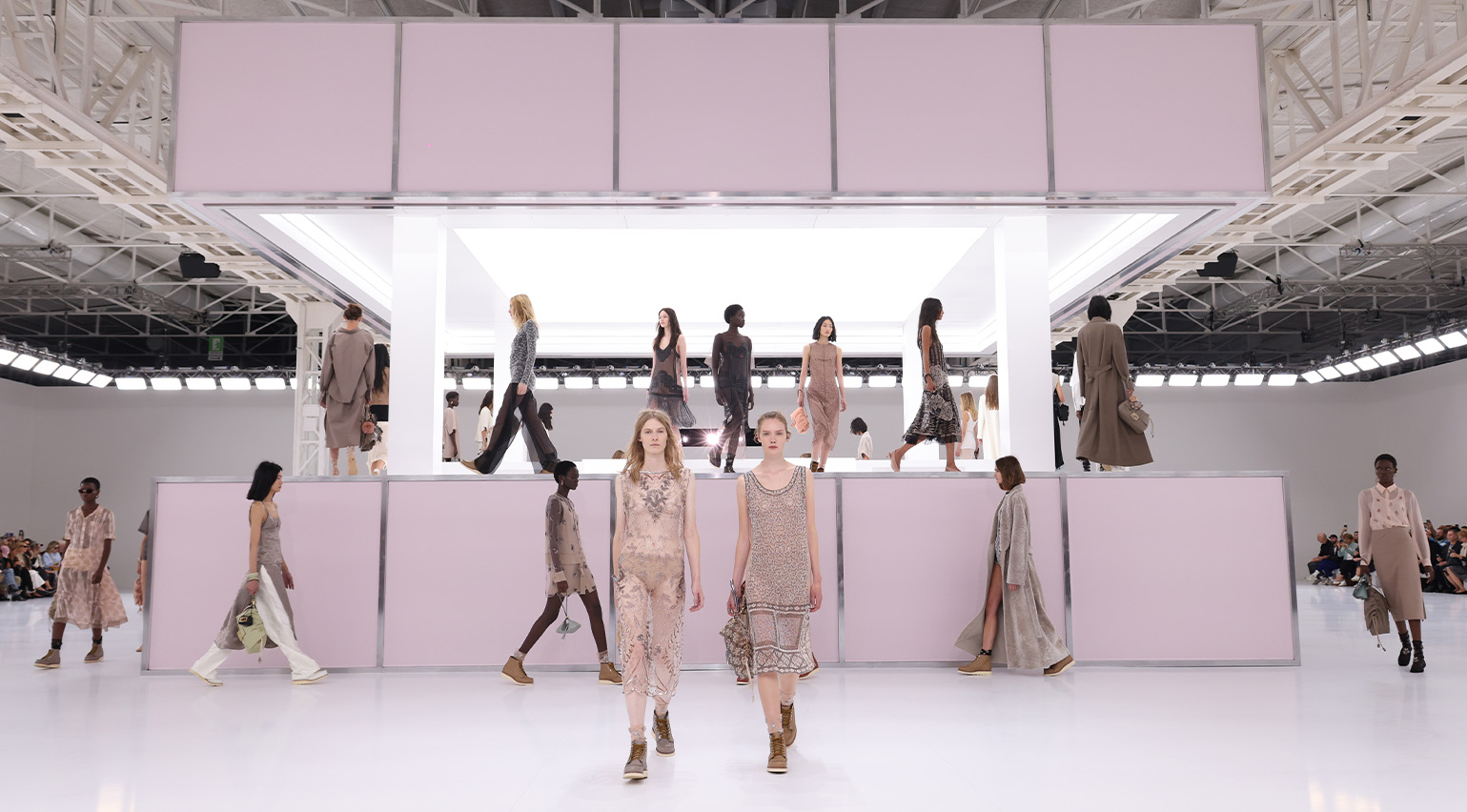 Kim Jones to exit Fendi after four years
Kim Jones to exit Fendi after four yearsFendi has announced that Kim Jones is leaving his role as artistic director of womenswear and couture at the Italian house, though will remain at Dior Men
By Jack Moss
-
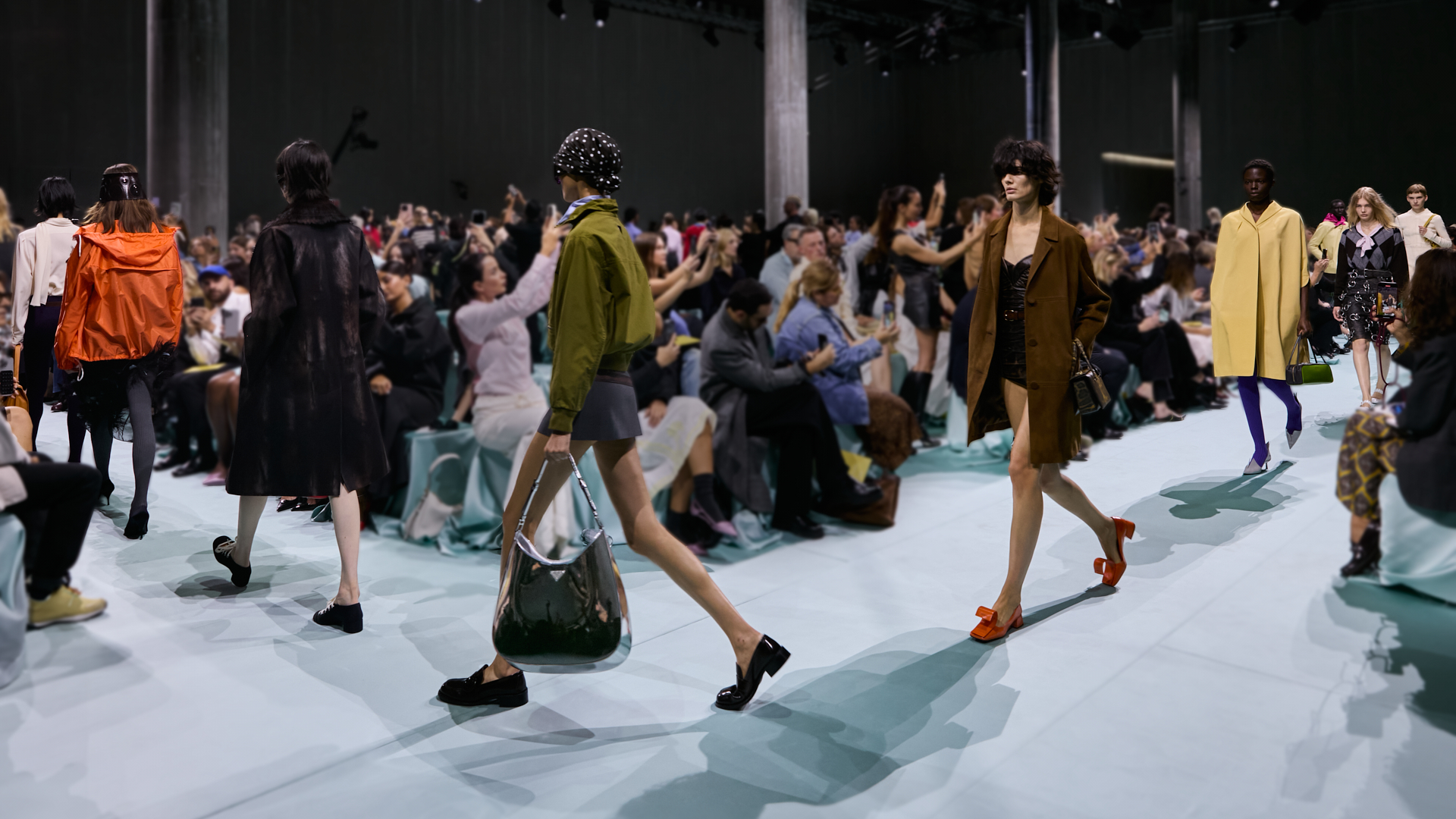 The Wallpaper* S/S 2025 trend report: ‘A rejection of the derivative and the expected’
The Wallpaper* S/S 2025 trend report: ‘A rejection of the derivative and the expected’Wallpaper* fashion features editor Jack Moss unpacks five trends and takeaways from the S/S 2025 shows, which paid ode to individual style and transformed the everyday
By Jack Moss
-
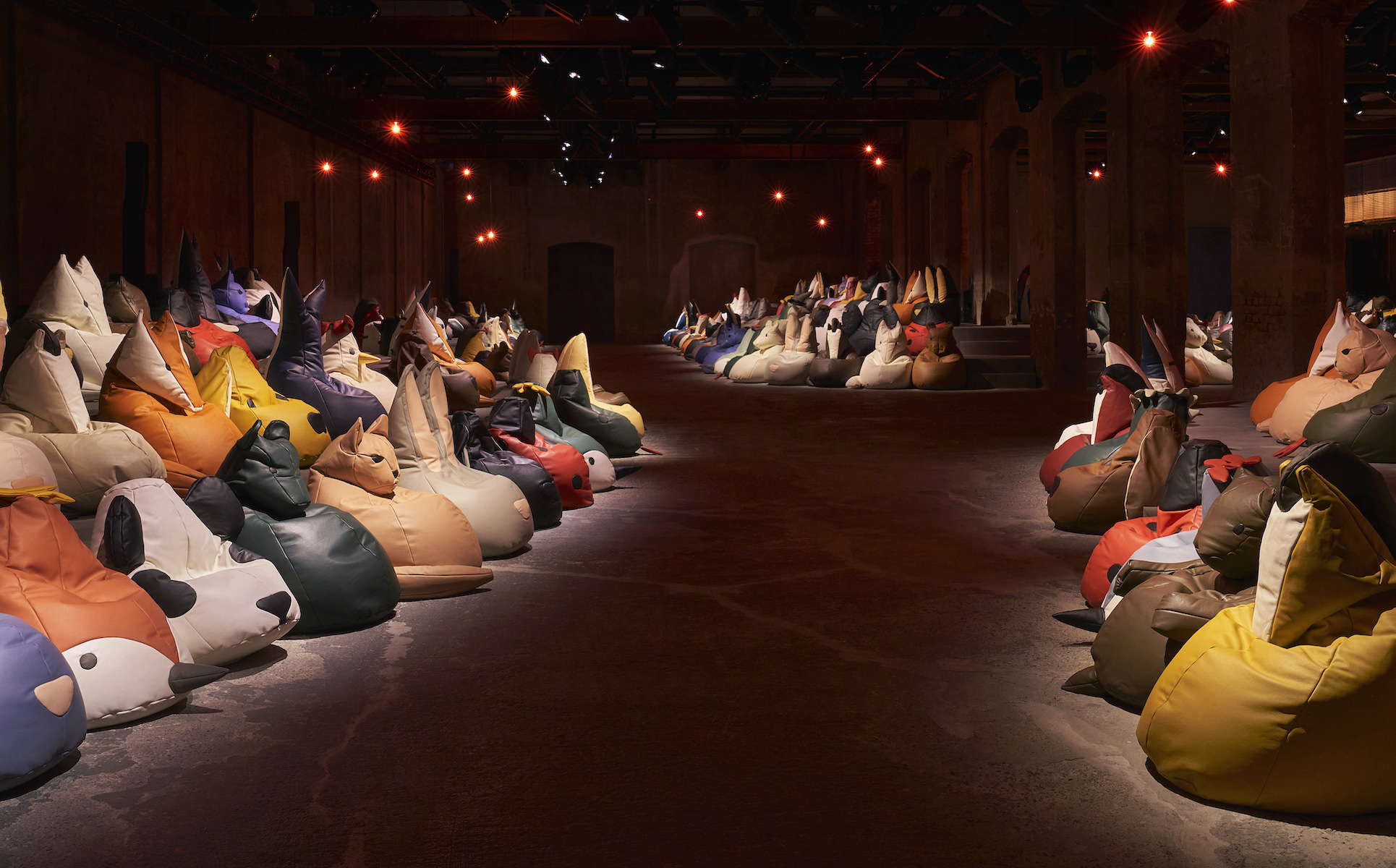 The breathtaking runway sets of S/S 2025, from beanbag animals to a twisted living room
The breathtaking runway sets of S/S 2025, from beanbag animals to a twisted living roomWallpaper* picks the best runway sets and show spaces of fashion month, which featured Bottega Veneta’s beanbag menagerie, opulence at Saint Laurent, and artist collaborations at Acne Studios and Burberry
By Jack Moss